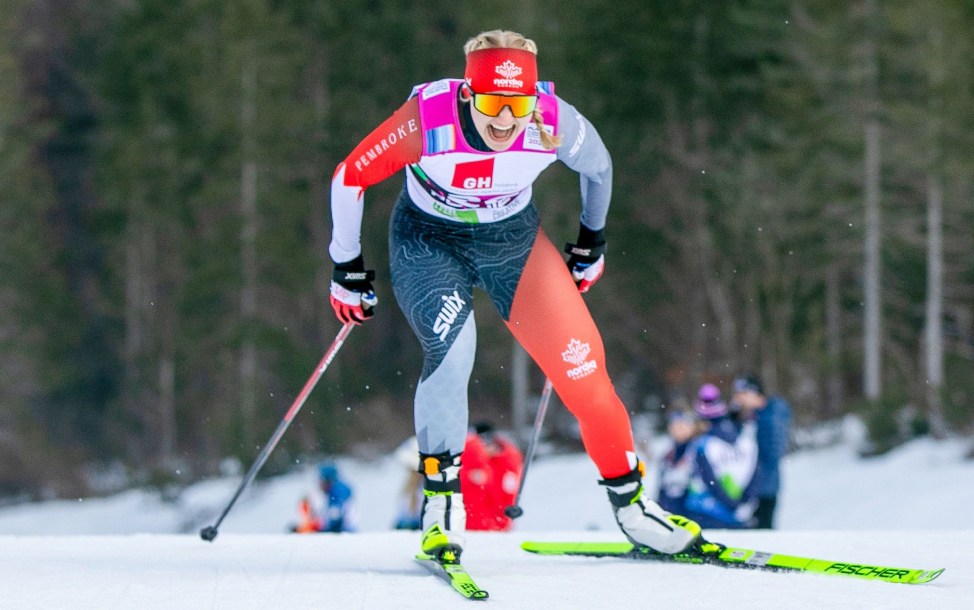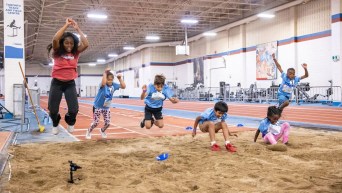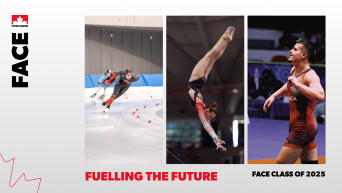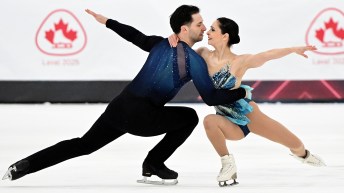“That really lit a spark in me”: Cross-country skier Sonjaa Schmidt is a rising star on the World Cup circuit
Team Canada’s Sonjaa Schmidt is making herself known on the FIS Cross-Country World Cup circuit.
The 22 year-old from Whitehorse, Yukon had a breakthrough season in 2023-24 that included a gold medal in the freestyle sprint at the FIS Under-23 World Ski Championships. Schmidt was the first Canadian woman to win a U23 world title in cross-country skiing.
This season, Schmidt is continuing to prove herself to be one to watch, notching her best-ever World Cup finish—a fourth place finish in freestyle sprint in Engadin, Switzerland in January. That final included some of the top names in Nordic skiing, among them Olympic and world champions Jessie Diggins of the USA and Jonna Sundling of Sweden.
Olympic.ca caught up with Schmidt ahead of the 2025 FIS Nordic Ski World Championships to chat about preparation, racing, and her slightly unusual off-season training.
How did you get into cross-country skiing?
I’m born in December. My dad said, “If she can walk, she can ski.” And my parents tell me I was suddenly walking at 10 months. When the first snowfall came that season, they put me on skis. I was technically on skis before my first birthday!
Ever since then, skiing has just always been something that I did. I’m born and raised in the Yukon, in Whitehorse. I went through the program that they have there for skiing and then I started really doing it competitively in like grade 11/12. After that I went and joined the Alberta World Cup Academy that’s based out of Canmore, Alberta. They have a training group in Calgary for people who want to go to school. So I did the Calgary program and went to school there, and that’s where I really started to improve a lot and make the world stages.
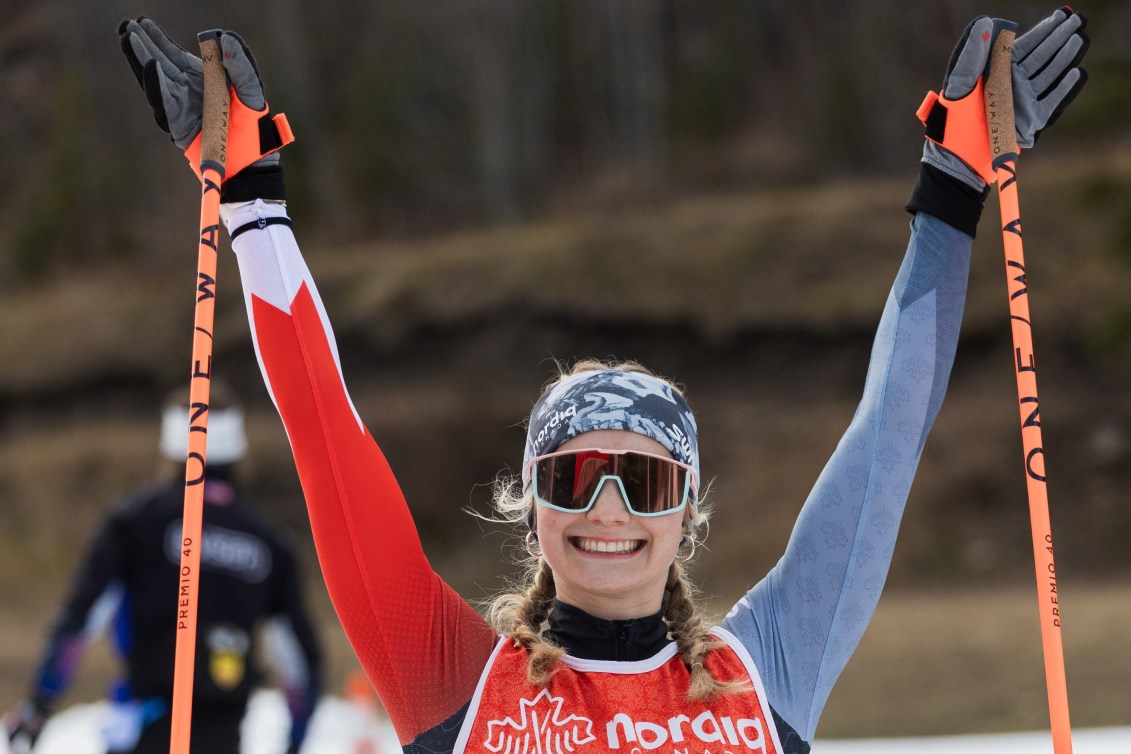
Was there any moment, or result, or point in time that you realized you could race at the highest levels?
For the longest time, my biggest goal was to make the world junior and U23 championships. I made it in 2023, when it was happening in Whistler, so it was on home land, which was a really cool experience. I only got to do one race there, and it was a sprint, and it was only a qualifier, so it was a three and a half minute race, and that left me wanting more.
Last year in Planica, Slovenia, I qualified again, and it was my first time leaving North America to go on a ski trip. I was really happy to be there, and I ended up taking gold for Canada in the skate [freestyle] sprint. That was that result that made me realize, “whoa, I could do some really good things!” That just really lit a spark in me.
You’re just coming off of the U23 world championships this season—how did it go?
I was going in [to the event] saying that I wanted to defend my world champion title. But that being said, it was a classic sprint, and the year before was a skate sprint, and I’m definitely a lot stronger at a skate sprint. I knew that, so I was pretty happy with my result in the classic sprint [Schmidt finished 12th]. I also did the 10 kilometre skate, which I was really happy with. [She finished eighth].
And you had a fourth place finish on the World Cup circuit this season in Engadin—your best World Cup finish ever. How did that feel?
That was my first race weekend back on the World Cup [circuit] after being back home for Christmas and back in Calgary for some training. I got to Engadin, and I was feeling really good. I was really excited to start racing again, and I had actually finished my school in December, so I didn’t have any school stress on me. That whole day, I just felt amazing. The sun was shining, it was good weather, the music was good. I was just like, “what a good day for a good day.”
Can you explain how a sprint works?
Typically, there will be anywhere from 50 to 70 athletes in the women’s field at a World Cup. A sprint works where you will do the first lap, which is like 1.3 kilometres, something around there, and everyone will be spaced out by 15 seconds. That’s called the qualifier.
The top 30 people make it into heats, and then they divide the 30 people into five heats of six. The top two [from each heat] will move on, and there’s two lucky losers, which are the next fastest times.
Then you have 12 people, and it’s the same sort of deal—first two automatically move into the final, and then there’s two lucky losers. It all gets narrowed down to there being one final heat of six people, and that’s where you fight for a top three, basically. So that’s where I came fourth.
I’m sure there must be some strategizing then about how hard you’re going to go in the earlier rounds, can you explain that?
Yeah, typically in heats, I will not normally lead, and I’ll try and conserve as much energy as possible. Especially at a World Cup, if I’m in a heat, I’m trying to be behind the pack, just to conserve energy and then make a move where I can near the end.
Though, in my quarterfinal [at Engadin], I remember skiing up the hill, and there was a really strong competitor on my right side, and the four other athletes in the heat were behind her, and then I was on the left side. In that moment, I realized, if she makes it to the top of the hill before me, and it was a left hand turning corner, she was going to end up cutting me off with everyone behind, and I was just going to get left behind. So in that moment, I was like, I have to go!
So I upped my speed and I ended up leading the downhill. But after looking at my qualifying time and the splits, the second half of the course was my strength, and that’s where I ended up qualifying. I knew that if I got enough speed in front, that the rest of the heat wouldn’t be able to catch my draft. I stayed in front. In that moment, it was already really amazing that I kept in front the whole time and ended up making the semifinals. Making a semifinal at a World Cup alone is cool. I was excited to be in the top 12, and then moving on from the semifinal to the final as a lucky loser was really incredible,
Do you have a preferred technique and distance that you like?
I always liked distance races when I was growing up. It was only last year [when] I did really well [at the U23 worlds] in Planica, the skate sprint, that I started to like sprinting more. In skate technique, I’m a lot more powerful and it just makes more sense to me. I’m still working on my classic but I definitely prefer skate.
Can you talk about your slightly unusual off-season training?
I’m a tree planter. I’ve done it for two seasons now, and I believe that it’s a lot of the reason why I’ve had success with skiing.
In 2023 I ended up not making the national team, and I lost my funding from the national team. I was left wondering, how am I going to do this? My roommate said, “I could get you a job tree planting. It’s gonna be hard, but it’ll probably complement your training.”
And I was like, “Okay, sign me up!”
So I went in 2023 and I did it for I think 11 weeks. I would have been training for those two and a half months, but I needed to make the money, and so I did that, and then I did the rest of my summer training. And the next season, which was last year, I had some really incredible results, both within Canada, but then also at the U23 championships and it was my first time making the World Cup. It was just a really big turning point.
And then I was like, you know, maybe I have to credit tree planting! I went back in 2024 and I don’t think it’s been anything but good for me, because it’s got me to where I am now, and it’s something that I really do love.
It’s not your typical path for a professional athlete to take, but for me, it works. It’s nice to have something to take your mind off of skiing. I love skiing and I love training, but sometimes the stress can get really intense, and so it’s nice to have that.
What’s something that you wish people knew about cross-country skiing, or you feel like people get wrong about cross-country skiing?
People think cross-country skiing is boring, but it’s not boring! Especially when the downhills get really icy and you have to maneuver them…you’re getting up to like 60-70 kilometres an hour!
What’s your favorite moment of your own ski career?
Definitely my U23 sprint in Planica. I was the first Canadian woman to win a U23 race. Seeing all the reaction videos from my friends, it was a really special moment, special day. And it was a really big turning point for cross-country skiing for Canadians as a whole. I think it opened up doors that people didn’t think were possible to open. People really started to think that we could be on the podium on the world stage.
Do you have a favorite moment as a fan in your sport?
I guess I have a couple. I always love watching Jonna Sundling and how she dominates the rest of the field in sprinting. Definitely just as a fan, she is really amazing.
But also—back to Planica—I was a fan when the [Canadian] relay team took home gold! I wasn’t on the relay team, which I really would have loved to be, but that was also a really cool moment, especially for Canada. [The Canadian U23 team of Derek Deuling, Jasmine Drolet, Max Hollmann, and Liliane Gagnon took gold in the 4x5km mixed relay].
READ: Ski jumpers Abigail Strate and Alexandria Loutitt are making their dreams take flight
Rapid fire with Sonjaa Schmidt
If you weren’t a cross-country skier, what sport would you do?
I think I would do gymnastics or mountain biking.
Favorite workout to feel race ready?
We do something called “feel good intensity.” It’s pretty short, pretty sweet, kind of a mix of controlled skiing, and race-pace skiing, and then you do some hard fast spurts. It’s designed to make you feel good and feel race ready.
Favorite place to train?
I love training in Calgary and Canmore and, more specifically, in Kananaskis. There’s so many trails there that I just love going for long skis on.
What is the longest that you’ve ever skied?
On snow, I’m not really sure. Probably somewhere between 50-60 kilometres. But on roller skis, I did 100 kilometres [two summers ago]. It was relatively flat, and I switched techniques. I think it took me six and a half hours.
The FIS Nordic Ski World Championships will take place February 26 – March 9 in Trondheim, Norway.

